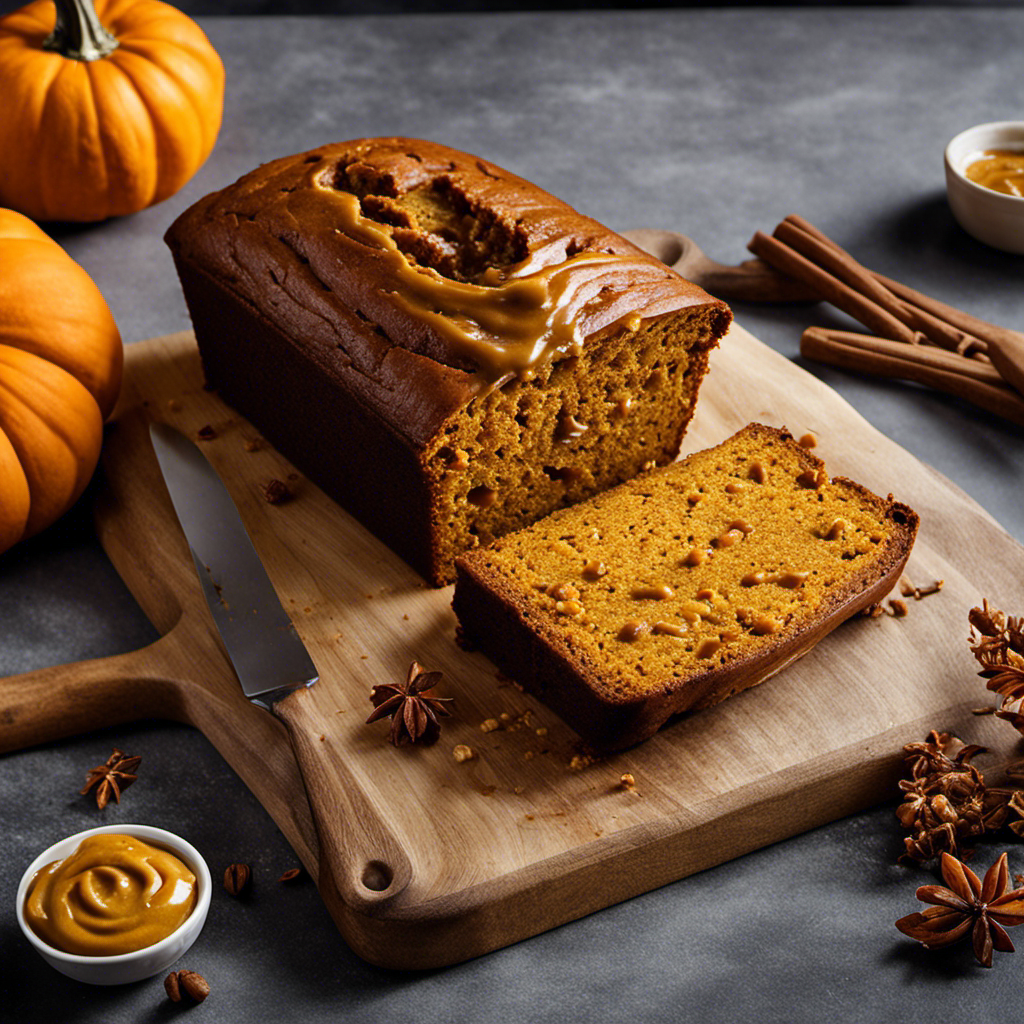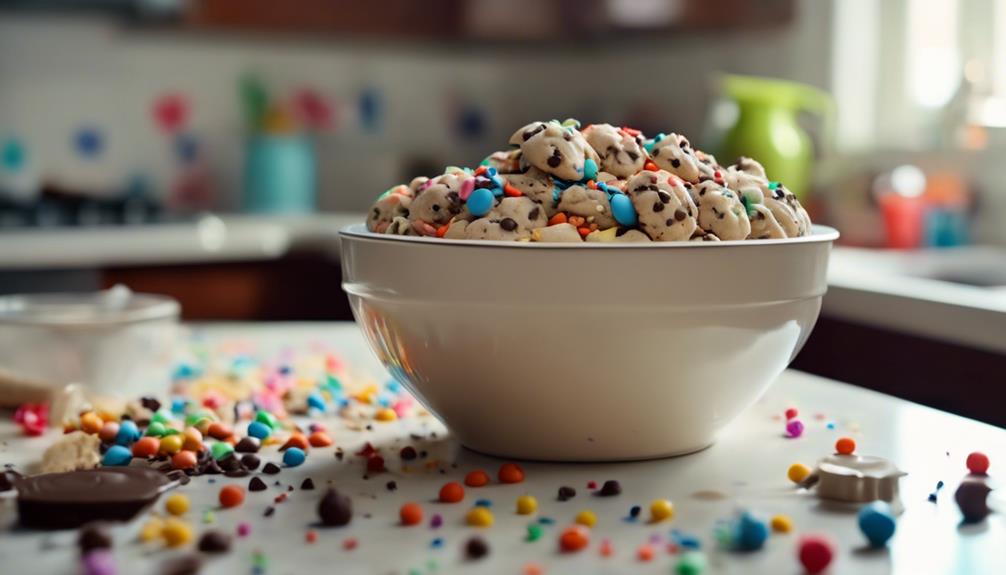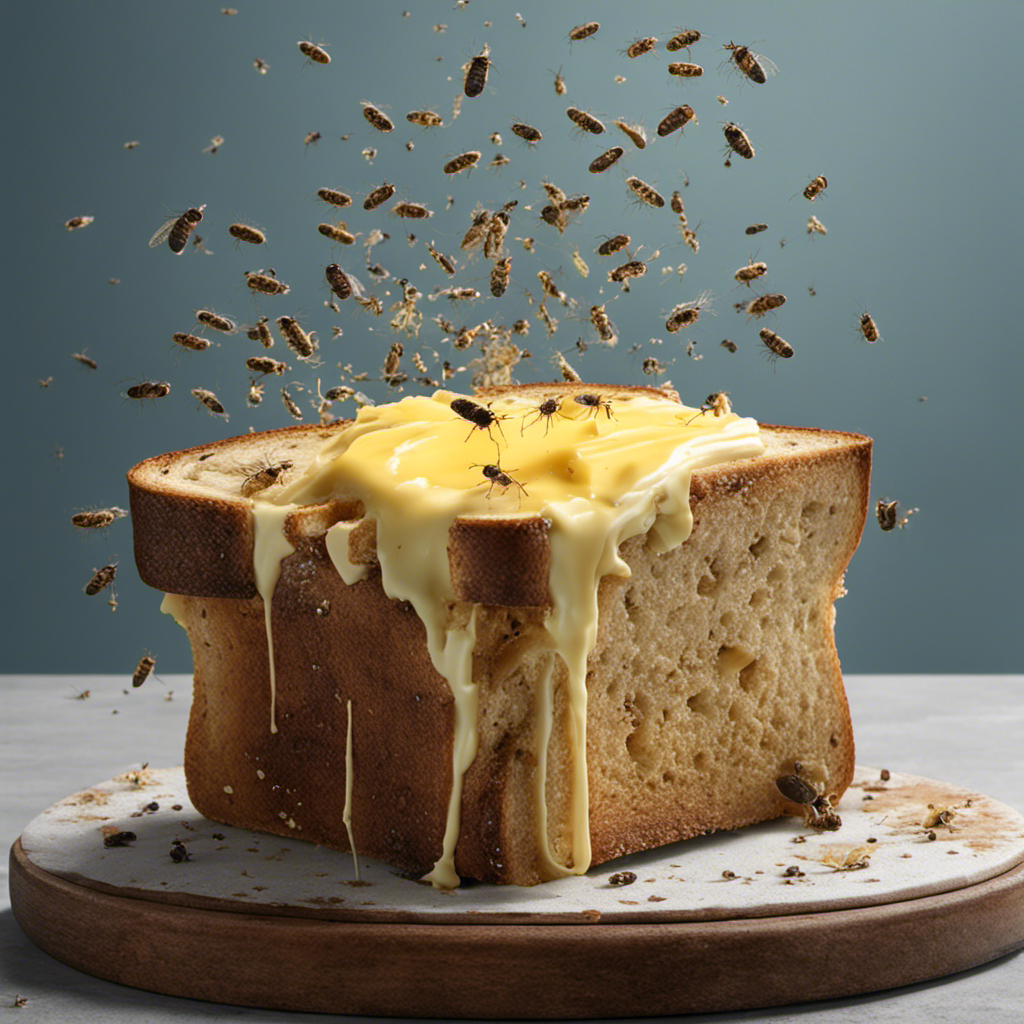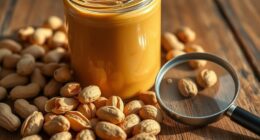While spreading a generous amount of creamy pumpkin butter on a slice of freshly toasted bread, I am in awe of the versatility of this tasty spread.
From enhancing the flavors of baked goods to elevating breakfast staples, pumpkin butter adds a rich and autumnal touch to a variety of dishes.
In this article, we’ll explore the many uses of pumpkin butter, from sweet desserts to savory creations, and discover why this seasonal treat is a must-have in your pantry.
Key Takeaways
- Pumpkin butter can be incorporated into pancake or waffle batter, muffin or scone batter, and pastries for added moisture and flavor in baked goods.
- Pumpkin butter can be spread on toast or used as a spread in baked goods like muffins, pancakes, and cookies.
- Pumpkin butter can be used in desserts such as cakes, cookies, pies, and ice cream to enhance the sweet flavor with its natural sweetness and warm spices.
- Pumpkin butter can be used as a sweet flavor enhancer in dishes like pumpkin bread, pumpkin spice lattes, and other desserts.
Baking With Pumpkin Butter
Baking with pumpkin butter adds a rich and flavorful twist to your favorite recipes. The creamy texture and warm, spiced flavor of pumpkin butter make it a versatile ingredient that can be incorporated into a variety of baked goods.
For breakfast, try adding a dollop of pumpkin butter to your pancake or waffle batter for a delicious autumn twist. You can also swirl it into muffin or scone batter to add moisture and a hint of pumpkin flavor. Pumpkin butter can even be used as a filling for pastries like turnovers or danishes, adding a burst of sweet and savory goodness.
With its natural sweetness and warm spices, baking with pumpkin butter is a delightful way to elevate your breakfast recipes and infuse them with the flavors of fall.
Now, let’s move on to the next section and explore the equally delicious option of spreading pumpkin butter on toast.
Spreading Pumpkin Butter on Toast
When spreading it on your toast, you’ll love how the creamy texture and rich flavor of pumpkin butter perfectly complement the warm and crispy bread.
Cooking with pumpkin butter opens up a world of possibilities beyond just spreading it on toast. This delicious spread can be used in a variety of recipes to add a touch of fall flavor.
It can be incorporated into baked goods like muffins, pancakes, and cookies, giving them a delightful pumpkin twist. Pumpkin butter can also be used as a dip for fruits, adding a sweet and tangy element to your snack time.
Imagine dipping apple slices or strawberries into a velvety pumpkin butter, the flavors melding together in a perfect harmony.
Using Pumpkin Butter in Desserts
Pumpkin butter isn’t just for spreading on toast – it’s a sweet flavor enhancer that can take your desserts to the next level.
This versatile ingredient can be used in a wide range of desserts, from cakes and cookies to pies and ice cream.
Get ready to indulge in unique pumpkin-infused treats that will satisfy your sweet tooth and leave you craving more.
Sweet Flavor Enhancer
To enhance the sweet flavor of your dishes, you can use pumpkin butter. It’s a delicious spread made from cooked pumpkin, sugar, and spices like cinnamon, nutmeg, and ginger.
Pumpkin butter is not only great for spreading on toast or pancakes, but it also adds a rich, sweet taste to your baking recipes. Imagine the aroma of freshly baked pumpkin bread or pumpkin spice cookies filling your kitchen.
And if you’re a fan of pumpkin spice lattes, just a dollop of pumpkin butter in your coffee can take it to a whole new level of deliciousness. With its warm and cozy flavor, pumpkin butter is a versatile dessert ingredient that can elevate any dish.
Versatile Dessert Ingredient
You can get creative in the kitchen and elevate your desserts with this versatile spread made from cooked pumpkin, sugar, and spices. Pumpkin butter is not just for spreading on toast or muffins; it can be used in a variety of baking recipes to add a rich and flavorful twist.
Imagine the aroma of warm pumpkin spice filling your kitchen as you whip up a batch of pumpkin spice cupcakes or pumpkin cheesecake. The creamy texture and sweet taste of pumpkin butter make it the perfect ingredient to enhance your favorite fall treats.
And let’s not forget about pumpkin spice lattes! By adding a dollop of pumpkin butter to your latte, you can take your morning coffee to a whole new level of deliciousness.
Now, let’s dive into some unique pumpkin-infused treats that will leave your taste buds begging for more.
Unique Pumpkin-Infused Treats
Get ready to indulge in some mouthwatering treats that showcase the unique flavors of autumn.
One delightful way to incorporate pumpkin butter into your fall festivities is by using it as a cocktail ingredient. Its rich, velvety texture and warm spices add depth and complexity to classic cocktails like the Old Fashioned or the Moscow Mule.
But why stop there? You can also create your own homemade ice cream infused with the delicious taste of pumpkin butter. Imagine creamy, decadent scoops of pumpkin-infused goodness, perfect for enjoying on a crisp autumn evening.
As we explore further, you’ll discover even more ways to incorporate pumpkin butter in breakfast recipes, allowing you to savor the taste of autumn from morning to night.
Incorporating Pumpkin Butter in Breakfast Recipes
One great way to use pumpkin butter in breakfast recipes is by spreading it on toast or bagels. The creamy, spiced pumpkin flavor adds a delightful twist to your morning meal.
But why stop there? Incorporating pumpkin butter in pancake recipes takes your breakfast game to a whole new level. Simply swirl a spoonful of pumpkin butter into the pancake batter before cooking and enjoy the rich, autumnal flavor with every fluffy bite.
If you’re feeling fancy, try using pumpkin butter as a filling for crepes. Spread a thin layer of pumpkin butter on a freshly made crepe, roll it up, and top with a sprinkle of cinnamon and a dollop of whipped cream. It’s a breakfast treat that will have you coming back for seconds.
Pumpkin Butter as a Topping for Yogurt or Oatmeal
Spreading pumpkin butter on top of yogurt or oatmeal adds a deliciously creamy and spiced twist to your morning meal. The smooth texture of the pumpkin butter blends perfectly with the creamy yogurt or warm oatmeal, creating a delightful combination of flavors. The richness of the pumpkin butter enhances the natural sweetness of the yogurt or oatmeal, while the warm spices like cinnamon, nutmeg, and cloves add a cozy and comforting touch.
For those looking to add even more variety, pumpkin butter can also be incorporated into smoothies for a burst of fall flavors. Additionally, it can be used as a dip for fruits, providing a sweet and tangy dip that complements the natural sweetness of the fruits.
Now, let’s explore how pumpkin butter can be used in cooking savory dishes.
Cooking Savory Dishes With Pumpkin Butter
I absolutely love using pumpkin butter in savory dishes because it adds a unique and delicious flavor to my meals.
One of my favorite ways to use pumpkin butter is as a flavor enhancer for stews. It brings a rich and slightly sweet taste that complements the savory flavors of the stew perfectly.
Additionally, pumpkin butter can be used as an alternative pasta sauce base, creating a creamy and flavorful sauce that coats the noodles beautifully.
Lastly, I’ve discovered that spreading pumpkin butter on roasted vegetables adds a delightful glaze and enhances their natural sweetness. It’s a versatile ingredient that adds a touch of autumn to any dish.
Flavor Enhancer for Stews
Add a dollop of pumpkin butter to your stew for a delicious burst of flavor. The rich, creamy texture of the pumpkin butter adds depth to the stew, while the warm spices like cinnamon, nutmeg, and cloves infuse the dish with a comforting autumnal taste.
Here are five reasons why adding pumpkin butter to your stew is a game-changer:
- It adds a hint of sweetness that balances out the savory flavors.
- The natural sweetness of the pumpkin butter enhances the taste of the vegetables and meats in the stew.
- The spices in the pumpkin butter give the stew a warm and cozy aroma.
- Pumpkin butter acts as a natural thickening agent, creating a heartier and more satisfying stew.
- It adds a seasonal twist to classic stew recipes, making them perfect for fall meals.
Try incorporating pumpkin butter into your next flavorful stew recipe and experience the amazing taste it brings to your dish.
Alternative Pasta Sauce Base
To create a unique twist on your pasta dishes, try using a vegetable puree as a sauce base. One delicious and unexpected alternative pasta sauce is made with savory pumpkin. Pumpkin is not just for pies anymore! It adds a subtle sweetness and a creamy texture to your pasta dishes. To make this sauce, simply roast or steam a pumpkin until it’s soft, then puree it in a blender until smooth. You can also add some garlic, herbs, and spices for extra flavor. The result is a rich and velvety sauce that pairs perfectly with pasta. Here is a table with some ideas for savory pumpkin dishes:
| Dish | Description |
|---|---|
| Pumpkin Alfredo | Creamy pumpkin sauce tossed with fettuccine |
| Pumpkin Ravioli | Homemade ravioli filled with a pumpkin and cheese mixture |
| Pumpkin Carbonara | A twist on the classic carbonara with pumpkin sauce |
| Pumpkin Lasagna | Layers of pasta, pumpkin sauce, and cheese |
| Pumpkin Bolognese | A hearty meat sauce with pumpkin puree |
Try these recipes and enjoy the unique flavor of pumpkin in your pasta dishes!
Spread for Roasted Vegetables
For a flavorful and healthy option, try spreading olive oil on your roasted vegetables. Not only does it enhance the natural flavors of the vegetables, but it also adds a touch of richness and moisture. Here are five reasons why using olive oil as a spread for roasted vegetables is a game-changer:
- It creates a crispy and golden exterior, adding a delightful texture to your vegetables.
- The olive oil acts as a natural flavor enhancer, making the vegetables taste even more delicious.
- It helps to retain the nutrients in the vegetables during the roasting process.
- Olive oil is a healthier alternative to butter or margarine, as it is rich in monounsaturated fats and antioxidants.
- It provides a beautiful glossy finish to your roasted vegetables, making them visually appealing.
Pumpkin Butter in Holiday Recipes
Try using pumpkin butter in your favorite holiday recipes for a festive and delicious twist. Pumpkin butter is a versatile ingredient that can enhance the flavors of both sweet and savory dishes. It can be used in baking to add a rich and creamy texture to cakes, cookies, and muffins. Incorporating pumpkin butter in breakfast recipes like pancakes, waffles, and oatmeal can give them a warm and comforting taste of fall. The table below provides some ideas on how to incorporate pumpkin butter in different holiday dishes:
| Dish | Pumpkin Butter Ingredient |
|---|---|
| Pumpkin Bread | Replace some of the oil or butter with pumpkin butter for added moisture and flavor. |
| Pumpkin Spice Latte | Stir in a spoonful of pumpkin butter for a deliciously spiced twist on the classic coffee drink. |
| Pumpkin Cheesecake | Swirl pumpkin butter into the cheesecake batter for a creamy and autumn-inspired dessert. |
| Pumpkin Butter Cookies | Use pumpkin butter as a filling or topping for thumbprint cookies or sandwich cookies. |
Frequently Asked Questions
Can I Use Pumpkin Butter as a Substitute for Regular Butter in Baking Recipes?
I can definitely use pumpkin butter as a substitute for regular butter in baking recipes. It adds a deliciously unique flavor and moistness to the final product. However, keep in mind that it may not work as well in savory dishes.
How Long Does Pumpkin Butter Typically Last in the Refrigerator?
Pumpkin butter typically lasts for about two to three weeks in the refrigerator, but its shelf life can be extended by proper storage. It’s important to keep it sealed tightly and refrigerated to maintain its freshness.
Can I Freeze Pumpkin Butter for Later Use?
Yes, you can freeze pumpkin butter for later use! It’s a great way to extend its shelf life. When freezing, make sure to use airtight containers or freezer bags. It can be stored in the freezer for up to 6 months.
Is Pumpkin Butter Gluten-Free?
Pumpkin butter is a versatile spread that can be used in various ways. It can be used as a gluten-free alternative to regular butter and can be incorporated into a variety of recipes, such as pumpkin bread or pancakes.
Can I Use Pumpkin Butter as a Filling for Homemade Pastries or Pies?
Sure, you can totally use pumpkin butter as a filling for pastries or pies. It’s not just for spreading on toast or topping ice cream. It adds a deliciously rich and autumnal flavor. Get ready for some seriously scrumptious treats!
Conclusion
In conclusion, pumpkin butter is a versatile and delightful ingredient that can elevate your culinary creations to new heights.
From baking sweet treats to spreading it on warm toast, its rich and creamy texture adds a touch of indulgence to any dish.
Whether you’re enjoying it in breakfast recipes or using it as a topping for yogurt or oatmeal, pumpkin butter brings a comforting and cozy feel to your meals.
So why not add a dollop of this autumnal goodness to your holiday recipes and savor the taste of pure bliss?










